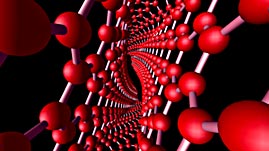Teachers' Domain - Digital Media for the Classroom and Professional Development
User: Preview

Source: Produced for Teachers' Domain
In this interactive activity produced for Teachers' Domain, explore five categories of nanotechnology applications: computers and electronics, energy and the environment, health and medicine, sporting goods, and clothing and textiles. Within each category, learn about products that use nanotechnology, such as batteries, hard drives, fuel cells, insulation, solar cells, cancer medicine, sunscreen, vaccines, bicycles, golf clubs, tennis rackets, bacteria-fighting fabrics, and stain-proof clothing.
Nanotechnology builds and makes use of materials at the atomic and molecular scale. The applications of nanotechnology are widespread, and researchers are actively pursuing new ways to use nanotechnology in many fields, from textiles and sporting goods to medical treatments and alternative energy sources. Nanoscale structures are typically defined as between 1 and 100 nanometers in size (one nanometer is one-billionth of a meter) and it is this tiny size that makes the technology so special. Nanotechnology is desirable for many reasons. For example, nanoscale structures can fit in extremely small spaces and have very little mass. Such small devices can also be more energy efficient, faster, and in some cases cheaper to produce than larger devices.
In addition, materials exhibit special properties at the nanoscale. Because of quantum effects and an increase in the surface area-to-volume ratio, the properties of some materials change when reduced to extremely small sizes, causing them to behave differently. For example, materials that are usually insulators might become conductors; substances can change color or go from opaque to transparent; melting points can change; and inert materials can become catalysts. Such unique properties of materials at the nanoscale enable the diverse range of nanotechnology applications.
Although the scope of applications is huge and seemingly unrelated (how could sports equipment and biofuels use similar technology?), the underlying principles of nanotechnology tie many applications together. Nanotechnology brings together scientists and engineers from many fields, including chemistry, biology, physics, optics, electronics, energy, and biomedical engineering. Nanotechnology researchers share a common goal: manipulating matter at the nanoscale.
There are two approaches to nanofabrication—top-down and bottom-up—and each has limitations. The top-down approach uses processes such as photolithography to remove material to produce nano-sized structures; it is a relatively well-established method and has been used to great effect in microtechnology to make integrated circuits and micro-sized mechanical devices. However, there are limits to the size of the features that can be produced using the top-down method. The bottom-up approach builds a structure by adding and moving atoms and molecules. It is an exciting and promising area of research. A variety of techniques, including catalysts, stress fields, electric fields, and van der Waals interactions (which work with other forces within and between molecules), can be used to guide the assembly of nanostructures, although it is challenging to get the structures to grow as desired.
The National Nanotechnology Infrastructure Network (NNIN) consists of 14 nanotechnology facilities, supported by the National Science Foundation, which provide support for users from both academia and industry. These facilities have state-of-the-art equipment for nanoscale fabrication and synthesis, as well as materials characterization capabilities (such as atomic force microscopy or scanning electron microscopy), extensive clean rooms, and expert staff to train and assist researchers. Researchers from all different fields can use the facilities to help with their own specific research needs.
 Loading Standards
Loading Standards Teachers' Domain is proud to be a Pathways portal to the National Science Digital Library.
Teachers' Domain is proud to be a Pathways portal to the National Science Digital Library.
